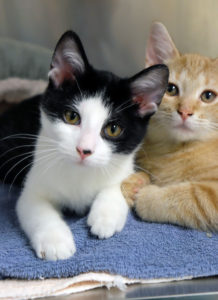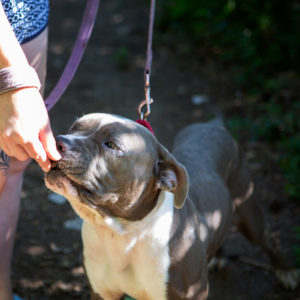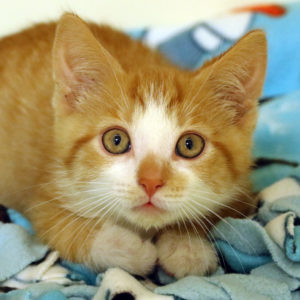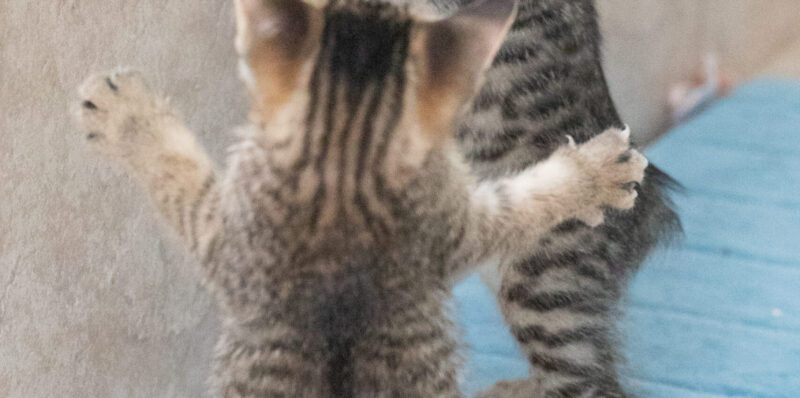
Did I adopt a kitten… or a T-Rex?
Winter’s a great time to flirt with your dog
Wondering how to exercise your dog in winter? Try flirting! A flirt pole, that is! Flirt poles are like oversized cat wand toys with a fleece or plush toy at the end. And dogs go bonkers for them!
Why your dog rolls in (stinky) stuff
It never fails; no sooner does Fido return from the groomer looking clean and smelling fresh, then he finds something gross and stinky to roll in! Why do dogs insist in rolling in smelly stuff, and what can you do about it?
We Can—and Should—Coexist with Urban Wildlife
Local governments are increasingly facing challenges from urban wildlife. As we expand into natural habitats—and restore green spaces and waterways—encounters with animals like deer, coyotes, and beavers are inevitable. What’s troubling is how often the response is reactive, violent, and uninformed. The recent killing of a family of beavers at Ann Arbor’s Leslie Park Golf Course is a case in point. Beavers are remarkably intelligent and ecologically vital—nature’s engineers. But when conflict arose, the only response was lethal removal – reportedly using gruesome Conibear traps that are illegal in Ann Arbor.. It was stated that there was a search for guaranteed solutions before choosing killing. But no intervention comes with a full guarantee, of course, and killing is no exception. It doesn’t solve the problem. Remove animals, and others simply move in. It’s a costly, ineffective cycle that ignores root causes. Beavers are as astounding as they are adorable—heroes in the fight against climate change. Destroy their dam, and they’ll rebuild it in days. Some communities reintroduce beavers to help restore ecosystems with their miraculous dams that slow water flow, reduce erosion, filter pollutants, and support entire webs of life. Before European colonization, hundreds of millions of beavers shaped our landscapes, creating wetlands that nurtured biodiversity and regulated water flow, preventing flooding, drought, and wildfires. But by the 1800s, like so many other species, they were nearly wiped out through intense trapping and habitat loss. But as they return, so do the conflicts. Too often, we forget how to live alongside these vital creatures—and react with hostility instead of wonder, respect and gratitude. We can do better. We know what works. Pond levelers and “beaver deceivers” are simple, affordable tools that manage conflicts—without harming beavers or disrupting their habitat. Groups like the Beaver Institute have proven their effectiveness nationwide. Where unique site challenges arise, humane alternatives exist and should be part of a management plan developed in partnership with experts eager to help. Ann Arbor has invested millions in preserving and restoring natural areas—successes that have allowed biodiversity to thrive. But this progress should come with respect and patience. These spaces aren’t museums—nature isn’t meant to be tidy or static. These are living, dynamic places, and we certainly can’t expect wild animals to follow human rules. With our collective voice, we recently stopped the DNR’s plan to gas Canada geese and their goslings—a cruel, outdated method of population control. But the pause is temporary. If we want lasting change, we need to do more than fight isolated incidents. We must convince policymakers that animal life has intrinsic value and that our wild neighbors have a right to live, too. We have the tools. We have the expertise. We just need the will to prioritize holistic, humane, science-based solutions over outdated reactions driven by fear or convenience. Fortunately, some communities are showing how coexistence is possible—resolving wildlife conflicts with education, tolerance, and expert support. Ann Arbor and Washtenaw County can lead this movement. We pride ourselves on compassion, sustainability, and innovation. Let’s ensure our approach to wildlife reflects those values. Our state regulatory agencies—DNR and EGLE—must also do better by removing barriers to humane, nonlethal solutions and ending the harmful practice of labeling animals like beavers as worthless “nuisances.” When we take killing off the table, we make room for real solutions—creative, collaborative, and lasting. Through our own actions, whether by design or ignorance, we invite wildlife into our neighborhoods and parks. To then kill them the moment they inconvenience us isn’t just short-sighted—it’s hypocritical and ethically indefensible. Urban wildlife is here to stay. The question is: do we respond with compassion and intelligence—or with traps and bullets?
FOR NEW ADOPTERS
Did I adopt a kitten… or a T-Rex?
Have you heard of the “T-Rex phase” of kitten-hood? It’s called this because kittens will sometimes stand up on their back legs, batting at things with their tiny front legs, running like crazy, much like a stampeding T-Rex. We use this phrase to describe the “terrible two’s” period of a kitten’s life, usually between eight weeks/three months to two years old, typically peaking at ten months. The age at which this phase happens and how long it lasts strongly depends on previous socialization and what they learned from mama, littermates and the humans they’ve interacted with. How did people play with and handle them when they were smaller? Did they grow up an “only” kitten, without littermates to learn boundaries from? Did they have stability and routine? Were they given tools to manage high energy? Some kittens are just more energetic and curious than others. Even if we give them the proper tools, they still need to explore and run, no matter how frustrating that can be for us. And remember, there is light at the end of the tunnel! With proper management and modification, your T-Rex can grow up into a loving, relaxed, happy lap cat… we just have to be patient and a good teacher. What behaviors might we expect? (Not a comprehensive list, as T-Rex kittens can be quite rambunctious!!) Biting and batting at things with paws, often with claws out Chasing moving legs, arms, hands Climbing humans and objects Scratching objects “Attacking” Boundless energy What can we do about this? What tools can we give them? Regular, extensive playtime with appropriate toys WAND TOYS!!! Keep those babies running, while also keeping them at a bit of a distance Limited handling As humans, we want to cuddle and pet our kittens, but remember, they’re living for fun and excitement right now, which means we need to meet them where they are. They’re not capable of shutting this energy off. Toys to help them learn independent play Battery-operated toys can be great! Enrichment Boxes! Create a maze of boxes with toys and treats inside for them to explore and chew on. Frozen treats Lick mats can work wonders to give your cat a distraction Freeze wet food or Churu in small ice trays and offer them in a bowl Shredded paper with toys or treats hidden in it for them to burrow into Snuffle mats with their meals hidden in them Make nail trims normal and rewarding using Churu or wet food to reinforce allowing nail trims If your kitten likes to pounce as you walk through a room, keep treats or toys handy to toss away from you, directing to the toy instead Redirect unwanted behaviors into something appropriate. We all learn better when we’re offered an appropriate alternative, instead of simply being told no. Time out doesn’t work for these little ones; it just builds frustration.
Ask me first, please! – Your dog
Have you ever reached towards the head of a dog to offer some petting, only for the dog to respond by lowering their head and ears and looking up with concerned eyes? Reaching suddenly towards a dog’s head or sticking out your hand above their head for them to sniff can be intimidating and cause a stressful start to your interaction. When interacting with a dog that is ready for petting, it’s important to offer consent checks! Dogs communicate through subtle body language and consent checks allow them to communicate whether they want to continue to engage with us, or if they want some space. First, offer your hand low, underneath the dog’s head (a good option is to feed a treat during this) then begin petting slow under the chin, chest, and shoulder area. Give pets for just a few seconds and then slowly pull your hand back. If the dog responds with positive body language (looking up at you with soft eyes, leaning in, pawing towards your hand, relaxed body, loose sweeping tail, etc.) they are looking for more interaction and petting! However, if you pull your hand back and the dog responds with any sign of FAS (fear, anxiety, stress) the dog is communicating that they need a break from petting. Some clear signs include leaning away, whale eyes, lip licking, front paw raise, tucked tail, back leg up exposing belly, and pinned ears. Just like people, some dogs prefer affection more than others, and there may be a time when your dog is feeling uncomfortable or tired and just wants space more than petting. Consent checks allow our dogs to effectively communicate their needs and help us build a positive relationship with them. The dogs in your life thank you for communicating with them through consent checks!
Bringing a new cat home?
When we’re speaking to adopters or planning for bringing a new cat home, what are some of the most important things that we need to keep in mind? Patience Cats thrive on routine and control. A cat moving from one home, or coming from the streets as a stray, to the shelter, to a new home is a lot for even the most easy going cat to handle. We have to give them time to decompress, discover the routine and understand their new environment and the people in it. Patience is key during this time, each cat has to do this on their own timeline. Resources You’ll need plenty of food, water and litterbox resources, but also keep in mind resting spaces, hiding spaces and toys. Your time is a resource, too. A shy cat will need you to spend time working with them to help them feel safe, while a more outgoing, active cat will need playtime and lots of attention. Living with other animals Make sure that you’re prepared with good tools (and a safe space) to manage separation and initial interactions, when everyone is ready for that. Remember that this cat isn’t going to be like the last cat that you had and that the behavior you saw while at the shelter may not be who this cat is. Each cat is an individual, just like you and me! Once they’re settled in, you may see a more or less active cat, they may be more affectionate and attention-seeking, they may be that lap cat you’re looking for. Meet them where they are and get to know them in each stage as they find their confidence again… you’ll probably be surprised by who they become!
Doggone grrreat indoor activities!
On days when our dogs are stuck inside, it’s important to provide physically and mentally enriching and engaging activities to help them burn energy and have fun! Some great options include: Working on training and basic cues. Games such as fetch, search and find, tug of war, and catch are just a few that can be played both inside and out. Dogs love activities that mimic part of the prey cycle. Try hiding an enrichment box with high value food or a long-lasting chew inside. The dog will use their nose to search for the enrichment (prey) and once they find it, they can shred it open and then consume what is inside. This satisfies several parts of the predation cycle and gives your dog an exciting activity that helps relieve stress! For social dogs, consider setting up extra play dates during the winter. Play sessions are highly beneficial and can help mitigate the effects of cabin fever. Interactive toys and feeders are popular tools, and you can even use multiple to feed your dog throughout the day. Freeze Kongs, lick mats, Nylabones, and other objects that can be smeared with peanut butter, cheese, or wet food to make a time-consuming frozen treat. Giving time consuming enrichment items can also be a great reward after training and a good decompression activity after high arousal play.
5 Steps to a Happy Cat
Whether you’re new to living with cats or have had them in your life for twenty years, there are some things that we should all keep in mind when providing the best care for our cats. Making sure that our cat’s most basic needs are met can make a huge difference in how they interact with us. A cat who’s comfortable in their environment, with all of their needs being met, is a happy cat!! Remember the litterbox rule! One litterbox per cat, plus one. If you have two cats, three litterboxes is the best way to go. It can seem like a lot, but offering more litterboxes to your cats is one of the very best ways to make sure they’re successful with the litterbox. Having litterboxes throughout the home, instead of in one room, is more appealing to your cat! Scooping regularly is a must! Stick with traditional clay or clumping litter, unless your cat is used to using a less traditional litter. If you decide to switch litters, do it slowly, over time, to make sure they like it! If your cat is older, has medical needs or has limited mobility, it’s best to tailor their needs to the litterbox. As cat’s age, they need lower entry, very large litterboxes with soft litter to feel comfortable in the litterbox. Make sure you offer plenty of feeding, resting, hiding and vertical spaces for your cats. Space is a huge resource for your cats!! Space to get away from stressors, space to hide, space to nap, space to eat that’s safe from other cats, dogs or kids, space to watch the birds outside, it’s all important! Lots of safe, positive interactions with the people in their lives. Having their body language understood and their space respected is the best way for a cat to feel safe and comfortable with the humans in their lives. Playtime and cuddling are a must! If you have a high energy cat, playtime is just part of how we help them to be successful in their home. Playtime can solve so many issues for so many cats, it’s like magic! If you have a cuddly cat, giving them the one on one time they need makes them feel important and loved. Provide alternatives for challenging behaviors. Make sure you have plenty of scratchers in the home, and that you’re working with your cat to use them. Offering cat trees and vertical space can help with cats who like to be on the counters. Enrichment and toys that encourage self directed play can help with a high energy cat when you’re away from your home. Making sure that you’re offering good outlets for energy, lots of attention and plenty of resources to your cats is a fantastic start to offering the best care possible to your cat.
Step by Step… Staying Together on Walks
Taking our dogs for walks is beneficial for many reasons. It allows them to burn energy and engage with mental enrichment through sniffing the environment. It’s a bonding experience that provides the chance to explore the world around us, with their favorite person at their side. During walks, it’s always important to ensure safety and proper use of equipment. Using a properly fitted martingale collar (Picture A) will prevent your dog from slipping out of their collar. For dogs who use a harness, it is recommended to clip a carabiner from the harness onto the martingale collar (Pictures B and C). Even a properly fit harness has some risk of the dog slipping a limb out or attempting to back out, so an added layer of protection is always helpful. In addition, you can take an extra step by attaching a locking carabiner (Picture D) to your regular leash, ensuring it will be impossible for the leash to accidentally unclip. Escape-proofing your equipment is the best way to ensure your dog will remain safely with their human during a walk.
Scruffing Cats: The Surprising Truth About This Common Handling Myth
As with anything in our ever-changing world, we know so much more about training and working with cats now, and it’s up to us to advocate for best practices when we’re thinking about how we live with our cats. Let’s talk about “scruffing” or grabbing a cat by the nape of the neck, to move, hold, punish or control a cat. Here’s what we know: The “flexor reflex,” causing cats and kittens to go limp when picked up by their scruff, stops within the first few weeks of life. A mother cat may bite down on a kitten’s scruff and move them only when they’re very, very young. A cat in the wild might be grabbed by their scruff during mating, fighting, or during a predator attack; all of which are stressful events in a cat’s life. Scruffing any cat beyond the first few weeks of life may result in a cat who seems calm and relaxed, but what we’re actually seeing is something very different. The cat shuts down because they feel they have no control, and shutting down is the safest option for them. Lack of behavior is behavior, and should be given appropriate attention. What you see as calm and relaxed could be, and likely is, a cat who’s given up because they feel they have no other option. What results can we see from scruffing cats — especially repeated scruffing? Fearful, defensive behavior Cats are prey animals who can move quickly to a state of fight or flight; both responses can lead to fearful, defensive behavior when they feel they’ve lost control. A lack of trust in humans Removing choice and safety from interactions leads to lack of trust, socialization and an increased fear response Handling sensitivities When lack of control and pain are associated with handling, cats can respond by biting or swatting during seemingly “normal” interactions. What can we do instead? If you need to move your cat from an unsafe situation, try wrapping them in a large blanket or towel. Covering their head and legs, if they’ll allow that, will reduce the stimulus around them and help them to feel safe. Work on training with your cat Cats can learn to stay off of counters and tables!! Carrier training works wonders for cats who are fearful of going into carriers Work with a Fear Free Certified veterinary clinic trained to handle cats in less invasive ways Check out this great article from Pamela Johnson-Bennett on scruffing for more information.
Deck the Halls, Not the Vet Bills: How to Keep Your Cat Safe for the Holidays
With the holidays coming up, there are some special considerations for the beloved felines in our families! From being away from home to having a house full of people, here are some ways we can help the cats in our lives to feel more comfortable and to be safe. Some of our favorite holiday plants are toxic for our pets or can be dangerous if ingested. Plants like poinsettias, Christmas Lilly, maryllis, mistletoe, and holly are all listed as plants that we’ll want our cats to steer clear of. If you’re planning on traveling, find someone to check in on your cat as opposed to boarding them. This can be the least stressful option for your cat. Cats feel safer in environments they know well, even if you’re not there, they’ll feel a whole lot better sleeping on their favorite chair over navigating an entirely new space that they don’t recognize. If you’re having guests over, make sure that your cat has plenty of safe spaces to retreat to, if they need that. Make sure that your guests know to respect your cat’s space. If your cat chooses to hide, allow them to do that, making sure to give them lots of love and attention when things are quiet again. For those of us who have cats who show a little too much interest in the Christmas tree, creativity will be needed! Putting ornaments up high on the tree can keep some cat’s curiosity at bay, while others will need any ornaments on the tree to be securely attached with extra wire to ensure that they can’t pull them off of the tree. Try putting cat-safe “ornaments” where a curious cat can see them. Many cat toys can be made to hang from your tree, and for some cats who just want to play with the ornaments, allowing them to discover and bat at toys hanging from lower branches can be a great way to allow them to interact with the tree while also keeping the rest of the tree safe. Some cats will need a physical barrier in front of the tree. As much as we may not love the idea, putting a play pen up around the tree can keep some cats out of the area all together. Avoid using tinsel and make sure that the lights on your tree are safely secured. Unplug the lights when you’re not available to monitor your cat with the tree. For more tips on holiday safety, check out this great article! https://www.avma.org/resources-tools/pet-owners/petcare/holiday-pet-safety
Moving with your dog: What to do before, during and after
According to U.S census data, the average American moves 11 times in their lifetime. When we relocate, our dogs are leaving their familiar place behind. This can be stressful, but there are things we can do to prepare and help them adjust to their new environment. Before the move: Keep your dog’s routine consistent. Be sure your pup is microchipped, wearing a collar, and the information is updated. Take them to visit the new place a few times before the official move, if possible. Encourage positive associations with the new home by giving plenty of treats and engaging in activities your dog enjoys. Pet-proof the new house by securing screens, windows, gates, doors, and checking fences for any gaps or damage. Consider talking to your vet about situational anxiety medications, if needed. During the move: Keep your dog in a secure area or with a familiar person during the bulk of the moving when doors are left open, and boxes are piled everywhere. Avoid leaving your pup unsupervised in an unsecure area of the new home or backyard (even if the fence is secure). Give your dog enrichment and activities to help relieve stress and keep them occupied. After the move: Have a designated area with your dog’s crate, bed, and some toys. Having a safe and familiar area will help them be more comfortable while they adjust to the new home. Stay home as much as possible in the first week. Be sure to continue your dog’s usual routines for walks, potty time, and feeding. Give your pup plenty of attention and positive interactions with their favorite things in the new environment.
Can I make my cat a lap cat?
One of the first things people ask when they’re adopting a new cat is whether or not the cat is a lap cat. The truth is that many adult cats are uncomfortable seeking out laps for a variety of reasons, but it’s important to know that we can help our feline friends feel safe enough to seek out and enjoy being close to us, even if they’ve had unpleasant experiences that have taught them otherwise. Find out what motivates your cat. Do they love Churu-style treats? Save those for when you’d like to work on some training with your cat. A high-value food motivator can be whatever your cat loves most, but it’s best to save those for training times. If your cat approaches, and you have the time, work in small steps to encourage your cat to come closer, eventually using that treat to encourage them into your lap. If they choose to stay, continue offering the treat, petting gently in the “safe zones” of the face and cheeks as long as they remain relaxed in your lap. Don’t push! Allow them to choose where they want to be. Be consistent. Continue working with treats and gentle, mindful handling until your cat is consistently seeking lap time. You can eventually fade out the food motivator when they’re seeking this interaction consistently and seem content with gentle pets and your warm lap. Pay attention to your cat’s body language. We should allow them to move away when they choose to. Never force your cat to be close to you if they’re asking to move away! Avoid too many pets. It’s all too common for us to stop paying attention to the cat in our lap as we watch our favorite show… Overstimulation can happen at any time; it’s very easy to miss the signs if we’re not paying attention. This can take time, and some cats just aren’t going to love being in your lap, but more often than not, you can train them to want to be close, even if the lap isn’t exactly where they want to be.
The care and handling of a new kitten
With kitten season in full swing, here are some tips to help you and your newly adopted kitten be as successful as possible! If possible, adopt two kittens! The best way to burn kitten energy is to let them play with another kitten. And trust us, burning kitten energy is possibly the most important thing you’ll need to do with your new friend! Give your kitten a safe, kitten proof space at first. A bathroom or bedroom will be perfect. Make sure they have food, water, litterbox and lots of toys in their room and let them explore the home when they’re confident and curious. Plenty of litterboxes are a must! Tiny cat means tiny bladder…. Once that little one gets playing and roaming, he may not remember where his litterbox is in time, but if you have plenty of boxes for him around the home, this won’t be an issue. Kittens often have two modes: play and sleep. Make sure that when play is engaged, you’re offering tons of high energy games that keep your kitten moving and exercising. Choose toys that encourage hunting, biting, and grabbing. By utilizing toys that allow for these behaviors, your kitten can learn what’s appropriate to bite, grab and hunt! It’s hard to remember, but a kitten in full play mode doesn’t want to be petted. He wants to play! Trying to engage in affection when your kitten isn’t done playing could result in bites and scratches. If he approaches in a very high energy manner, redirect into play or a fun activity, don’t try to calm him with physical attention. Intros with other cats and dogs must be done slowly. Kittens move and react in very different ways than an adult cat might, and their energy is sometimes hard for other animals to accept. In many ways, kittens can be easier to introduce, but managing energy and response to other animals will make things a little trickier at times. Make sure your kitten is being handled with care by all members of your home. Rough play with hands and being picked up or carried in a rough manner will only result in an adult cat who has learned bad manners… which makes things much more difficult for you!
Why you want to get a D in Dog Training
Working on basic training is a great way to bond with your dog, increase their skillset, build their confidence, and improve their quality of life as well as your own. We always use positive reinforcement to teach dogs which behaviors are appropriate, and what we want to see more of. Did you know that there’s plenty more work to be done after your dog successfully knows how to perform a basic cue like “sit”? When we start teaching a new cue, we want as few distractions as possible, so the animal can focus on the task at hand. Once they’re able to successfully perform the action, we can start to increase the “Three D’s”: distance, duration, and distraction. When we first teach “sit”, we generally start with a treat in our hand and lure the dog into looking up at the treat, causing their butt to sit down. Once they’re consistently sitting and know the verbal and hand cue, we can take a couple additional steps back and have them work on sitting while we’re further away. We can work on duration by rewarding them for sitting for increasing lengths of time and eventually teach them to sit until given a release cue. We can also work on having them sit with distractions present. Start with small distractions like focusing on sitting in the kitchen while someone opens the fridge, or sitting in the front yard while a neighbor walks by. From here, we can work up to bigger distractions like practicing “sit” while at a park with various stimuli nearby. Focusing on basic cues while adding distractions, distance, and increasing duration, is a great way to work on your dog’s concentration, impulse control, and continue to strengthen and build your relationship!
How to pick the right cat for you
You’ve decided you’re ready to adopt a cat! How do you pick the right one? Here are some tips to keep in mind when looking for the best fit possible for your lifestyle. If you have an active home with lots of people or kids, look for a cat who is actively seeking attention. These kitties may be cats who adjust easily or are less concerned with lots of noise and commotion and who would likely do well in a busier home. If you have a very quiet home, or are away from home much of the day, keep in mind that adopting a more active cat means making sure that they have tons of good enrichment and active playtime to be really happy. A bored cat is a frustrated cat… and that can mean mischievous behavior if their needs aren’t met. An older, lower energy cat could be great for someone who’s away a lot or who has a very calm, quiet home. Kittens are a lot of work! They need training, socialization and interaction as much as a puppy does, which is easy to forget when you’ve got that little ball of fluff in your arms. A very shy cat can easily open up in a safe environment. The quiet, nervous cat you meet at the shelter could very well turn out to be a high energy, active cat once they know you better. Sometimes it’s hard to predict who a very shy cat will be once they are comfortable again, it’s important to be open to that possibility when adopting a shy cat. Each cat is an individual! Look for a personality and energy level that works for your lifestyle, the more attention paid to those important factors, the better off you and your new feline friend will be.
Operation Cooperative Canine (a.k.a., getting a dog’s buy-in for basic caregiving)
Cooperative care allows your dog to be a willing participant in a necessary activity that involves handling, such as nail trims, eye drops, brushing teeth, etc. It enables them to communicate when they are stressed and need a break from handling, creates a safe environment, and makes them more comfortable with the activity. For example, when a dog is experiencing stress during a nail trim, this creates negative associations and can make nail trims more stressful and more difficult over time. Instead, we can reduce stress by giving breaks when they’re communicated and heavily rewarding with treats and praise. Giving dogs choices helps build confidence, strengthens your bond, and gives a safe way to engage in routine vet procedures and other medical handling that may need to be performed throughout their lifetime. Here are some tips to get you started with working on cooperative care: Teach a start button behavior that will express consent for handling, such as a chin rest, sit, or a lateral recumbent position. Next, practice reaching towards them with your hand or a tool such as nail clippers while they’re performing the behavior. When the dog withdraws consent for handling by stopping the behavior, refrain from continuing to reach towards them. As you keep practicing, the dog begins to learn that the start button behavior is essentially an on/off switch for handling and allows you to gradually increase handling over time while keeping them comfortable and allowing them to opt out when they need a break.
Cat-astrophic eating
Do you have a cat who gulps their food, sometimes so quickly that they almost immediately vomit it back up? (Also known as “scarf and barf”ing?) Or maybe you have a cat who gobbles their food and then moves on to steal more food from their feline siblings? Here are a few tips to help with a cat who eats too quickly. Invest in a variety of feeding tools. Feeding puzzles and slow feeders can help slow your cat’s eating down so that they can both digest their food, and potentially prevent them from moving on to the food resources of the other cats in your home. Bonus: feeding puzzles can be a great way to enrich your cat’s environment, too! Here’s more on feeding puzzles for cats. Feed smaller meals more frequently. In doing so, you’ll slow down your cat’s eating habits and spread out feedings so that they’re not as hungry at meal times. Make sure you’re managing stress during feeding times. In a multi-cat home, it’s important that you have enough resources for all of your cats. This means that they each need their own feeding station, ideally separated from one another. Each cat has their own space, so that no one feels like they need to protect their meals. Avoid feeding at high energy times in your home. If you’re under stress and moving quickly, your cat will sense this. Make meal times happen at a space in your schedule that’s comfortable for you. Creating a schedule that works for you will also work best for your cat! P.S. Always speak with your veterinarian if your cat is vomiting regularly or scarfing their food. It’s always best to make sure there’s nothing of concern causing this behavior!
What’s positive reinforcement and why do we use it?
Why do we use positive reinforcement when training and working with our dogs? Positive reinforcement (also known as R+) builds trust and helps strengthen our relationship with the dogs around us. We use a mark and reward system to teach the dog when they are doing something right. This helps us effectively communicate behaviors that we want to see more from our dogs and helps them build confidence too! With R+, we mark using a clicker or a friendly “yes!” and then we reward the dog with a reinforcer like a high value treat. The dog quickly learns that the marker means they have done something good! We also use positive reinforcement to counter condition fearful stimuli (triggers). For this, we keep the dog at a distance where they are comfortable and not reacting to a trigger, and then mark and reward each time they acknowledge the trigger by looking at it. This helps the dog associate a trigger more positively and gradually reduces their fear. When working with your dogs at home, it’s a great idea to keep treats somewhere handy so you can mark and reward when you catch your dog doing something good! When they’ve done something inappropriate, it’s best to redirect them to an appropriate behavior. We avoid using aversive measures like punishment, shock/prong collars, leash corrections, etc. because these methods can suppress behaviors instead of addressing them, strain your relationship with the dog and cause additional fear and anxiety. This is why we always use science-based, positive reinforcement training!
Calming Your Anxious Dog
Our staff and volunteers spend hours each day walking the dogs and providing them with mental and physical stimulation that keeps them comfortable and happy during their stay. There are some dogs, though, who need extra attention as they struggle with arousal or fear. Aroused (high-energy) dogs can get overly excited and have a surge of adrenaline when it’s time to leave their kennel or go for a walk because it is often the highlight of their day. They benefit when we: Maintain calm Encourage four paws on the floor for leashing Refrain from lots of petting or excited baby talk when they are overly aroused During walks, give plenty of opportunities for your dog to stop and sniff their surroundings — it supplies mental stimulation while lowering arousal and stress. You can also try scattering treats on the ground; it helps them decompress and avoid increasing arousal as they enjoy sniffing out the treats! Taking a dog to a play yard can be a fun way to burn some energy, too; just remember to always pair play with decompression. Take frequent breaks during play sessions to work on basic training cues or sniff around for treats After play, take your dog for a calm walk and then allow them to decompress on their bed or in their crate with an enrichment treat like a stuffed Kong If you have a shy or fearful dog, give them a choice of whether they want to interact or not Tossing treats first is ideal, don’t force an uncomfortable dog to eat from your hand before they’re ready Go slow for leashing and help create positive associations with the experience by offering treats before and after clipping the leash Throughout the walk, give your dog plenty of treats as they engage with their surroundings. We want to help them build confidence and develop a positive relationship with you!
How to help your one and only kitten
While it may be hard to find peer-reviewed data on what we in the animal welfare industry call “single kitten syndrome,” anecdotally, we’ve all seen it time and time again. When a kitten is raised without littermates or a mom to teach how to interact with other cats and people appropriately, we have a lot more work to do as their human. Here are some important things to make sure you’re adding to your single kitten’s environment to help them thrive and interact with their world, and their people, appropriately. Enrichment Make sure that your little one has plenty of things to explore, investigate, and problem-solve in order to keep your kitten’s mind busy (and a busy mind is a tired body!), like: Feeding puzzles Cardboard box enrichment New and fun scents and textures Things to discover (think, hide and seek with catnip toys hidden in the pillows on the couch) Playtime There’s never enough playtime for a kitten, especially when you’re their sole playmate. They need toys they can attack and chew, wrestle with, and safely destroy and “kill.” Remember to rotate toys to keep them fresh and new for your kitten. Positive reinforcement and redirection Make sure to reward your kitten for making good choices (playtime or food treats are wonderful positive reinforcements for kittens!), and always redirect into appropriate actions when they’re being “naughty.” Is your kitten climbing the arms of the couch with claws extended? Give kitty a scratching post next to the couch and reward them for using it! Remember, punishment may work in the moment, but you’re damaging your bond with your kitten and they’re most certainly still engaging in the activity when you’re not home… so positive reinforcement and redirection are much more effective and better in the long run!
How to choose your kitty
It can be overwhelming when you come to the shelter looking for a cat or kitten to adopt. You may wonder what kind of feline will work best for your home, and how to tell which cat might fit that bill. Following a few general rules can help make that decision for you! Genetics, history, and socialization all play a part in who a kitten or cat is, or who they will be when they grow up. All cats have had different experiences throughout their lives that help shape who they are, so be prepared to offer lots of great socialization, playtime, enrichment, and love when taking them home. Kittens and young cats need a lot of playtime; they can become rambunctious and mischievous if they become bored, so make sure that you’re ready for that. Many of the adult cats in our care have some history from a previous owner that will give insight into who they are in a home. Don’t let that shy cat in the cage fool you! They may have been confident and high energy in their home, and this will likely be true in your home, too. If you’re looking for a calmer cat, look at an older cat. Cats can remain in adolescence until the age of five, so it can be safer to pick an older cat if you’re looking for a cat who’s a bit more laid back. Avoid gender stereotypes. Remember, sociability and interest in play can be a result of their upbringing, not their gender. If you’re looking for a specific personality, don’t discount a cat based on gender; you might be missing out on a great opportunity! When picking a cat to befriend your cat at home, the most important piece of advice (outside of previous experience with cats) is to match personality and energy level. Adopting a kitten for your 15-year-old cat can cause a high level of stress but adopting a kitten for your 1-year-old cat could be perfect! Overall, let your heart lead you, but try to keep these few tips in mind as you search for your new feline friend!
How to “enrich” your dog’s life
We all know how important enrichment is for our animals. Enrichment gives them the opportunity to engage in natural behaviors and provides them with vital mental and physical stimulation. Sniffing, chewing, shredding, and licking are all ways to relieve stress. Additionally, when a dog is experiencing heightened arousal from activities like a brisk walk or playing in the yard, engaging in enrichment afterwards is a great way to bring their chemicals like cortisol and adrenaline back down to a baseline level. Getting creative with enrichment is fun and we can even step it up by offering something like multi-layer shredding enrichment. For instance, you can recycle a paper bag a bag that contains two small boxes of treats to shred, a nylabone smeared with peanut butter, and a tennis ball!
How to introduce guests to your avoidant or reactive dog
Does your dog avoid or react to strangers? Bark, growl, run away, or hide? Here’s what we suggest. (Note: Please consult with a professional trainer for biting.) Prepare Yourself Make sure you are familiar with the dog’s behavioral history, what has and has not worked in previous introductions. Use correct equipment (collar/harness and non-retractable leash) and have high-value treats with you. Have a helper with you when introducing a dog that may struggle with new people. The helper can assist with handling the dog if there are problems, coach the guest and narrate what they are observing, provide a second set of eyes to monitor body language, and stay with the guest if you need to move the dog further away or remove them from the room. Handler should remain focused on the dog throughout the interaction – it may help to have the second person coaching and talking with the guest. Prepare Your Guest Speak with the guest before getting the dog. Give them some background on the dog, and give specific instructions on what they should do. Give the guest a bag of high-value treats that you know the dog likes (Cheese, deli meat, etc). Plan to have them seated where you will meet when you bring the dog in, and instruct them to: Avoid direct eye contact. Talk softly. Keep hands neutral and in their lap. Do not reach towards the dog or try to lure/coax them over. If dog orients towards them, they can toss or roll a treat in their direction with an underhand motion. They should try to have the treat land behind or near the dog, so that the treat doesn’t cause the dog to move forward. Wait to pet/touch the dog until the dog solicits contact. Have them pet three seconds then pause, and to pet the dog’s preferred areas of the body (usually neck/chest and shoulders). Petting may not occur at all. Prepare Your Environment Meet in a quiet area with plenty of space to get distance, ideally a location where the dog is comfortable. Possible areas include yards, living room. Have the guest seated on the opposite corner from the door or gate. Interaction Protocol 1) As you enter, stop, read the dog, and proceed slowly based on what the dog is telling you: If the dog starts to react with barking, growling, lunging, hard-staring, etc., then increase distance. If the dog is showing escape/avoidance, increase distance. 2) If the dog is approaching in a “bee-line” fashion, rapidly and directly, straining on the leash, and hyper-fixated on the person DO NOT continue to approach. Stop the dog and move them further away. Dogs approaching in this fashion may still be uncomfortable, but may be getting “magnetized” to the person and are trying to get close and seek information. That doesn’t mean that they are necessarily OK with the situation, and too often, these dogs might panic once they have gotten too close, and could escalate to aggressive behavior. For the same reason, we don’t want to lure the dog in with food. 3) Stay at a distance where the dog is able to be under threshold, can show some curious interest in the guest, and can also be easily disengaged. You can be offering the dog treats during this time, especially if the dog looks at the guest. 4) Gradually, get closer. Err on the side of caution and going slower than necessary. 5) If/when the dog does interact with the person, keep contact brief to begin, call the dog away, and give them the choice whether to re-engage. Move the dog away before any environmental change or transition, such as the guest standing up, walking, etc. as this can sometimes re-trigger a dog. If the dog is growing more comfortable in the person’s presence, you may try to take a parallel walk together. Again, don’t force any interaction. For some dogs, you may not proceed through these steps all in one visit, and additional visits may be needed if the guest is willing. On subsequent visits, start the process the same and build up again – don’t just jump to the place you ended on at the last session. Hopefully the process will go faster with subsequent visits. If not, it may not be worth pursuing beyond a couple attempts. If you cannot get the dog under threshold at all as long as the person is in view, or if at any point you are uncomfortable with either the person’s or the dog’s behavior, end the interaction. Body Language “Cheat Sheet”: Dogs looking like “playful” or “appeasing” dogs may be OK to allow to approach. Let “alert/aroused” and “fearful” dogs keep their distance.
Treating is Tricky: Making a plan for training
The legendary animal trainer Bob Bailey once said, “Training is a mechanical skill.” While it seems like it shouldn’t be complicated, it can be surprisingly tricky to juggle a leash, treats, clicker, and anything else you might need in a training session. Because learning happens fastest when consequences are clear and occur quickly after the behavior, we can end up confusing our dogs if we are fumbling, dropping treats, and delivering rewards late. Before a training session, it is a good idea to make a plan. Think about how you are going to hold the various equipment, decide how you are going to deliver treats, and make sure the training environment is free of unplanned distractions. As silly as it sounds, professional trainers also practice their mechanics without the dog present, making sure we can reach for a treat quickly, and deliver it to a human helper, plastic cup, etc. smoothly and efficiently. Troubleshoot any awkward mechanics first – it is much harder once you have a dog in front of you. That extra preparation time will save you plenty of time and energy in the long run.
Unmasking Cat Litterbox Problems
Cats get surrendered each year because of litterbox problems. We sympathize with both the cats and the people; no one wants a cat thinking (of their bathroom) outside the box! Litterbox issues can often leave cat guardians feeling helpless and upset with their cat. The first thought might be that the cat is lashing out or “getting back” at their owner for something, but it’s almost always something that we can identify and treat. The first place to check is with your veterinarian. They can take blood and urine samples and look your cat over for any pain or mobility issues that might be causing the litterbox issues. Something as seemingly unrelated as dental pain can cause accidents! An exam from the tip of the tail all the way to the tip of the nose can help resolve a litterbox problem. After that, consider how many litterboxes you have, where they are in the home, and how often they’re being cleaned. If you have multiple cats in the home, you’ll need one litterbox per cat, plus one. (ex: 3 Cats = 4 litterboxes) Spread the boxes throughout the home to ensure that each of your cats can find a litterbox when they need one. Covered litterboxes, using unfamiliar litter, or using electronic litterboxes can also cause issues. What kind of litter are you using? Are your boxes big enough for your cat? Is the entry appropriate for their level of mobility? Are the litterboxes in an area that is hard or scary for your cat to go to? Basements and laundry rooms are popular locations for litterboxes, but can be scary, damp, or hard to get to. Evaluate the stress levels of your home. Resolving household stress can go a long way to resolving litterbox issues. Is your cat getting along with the people and other animals in the home? Is there a new stressor in the home? Other cats outside where they can see them? Squirrels or birds? These things can be stressful for some cats. If you have a multi cat home, making sure that all resources are bountiful is important. Provide plenty of feeding stations, resting areas, hiding spots, vertical space, and scratching surfaces. For more on working through litterbox issues, check out this fantastic information from Pamela Johnson-Bennett, author of multiple books on cat behavior. Cat-astrophe averted!
Are you catching your dog being good?
It is great to have a dog that responds reliably to cues to “sit,” “stay,” “leave it,” “come,” etc., but wouldn’t it be great if your dog naturally did these behaviors on their own, before you even needed to ask? Often dogs get our attention when they are doing things we don’t like, but we aren’t as good at noticing all the times they are making good decisions naturally. If we train ourselves to notice those moments though, and reinforce them, our dogs’ good habits will become stronger. So, make a practice of “catching your dog being right.” Every day, set aside 20 small treats in a conveniently located jar. Your job is to notice and reward your dog when they are doing things you like, even without being asked. Notice when they go lie down on their bed while you are eating dinner, when they calmly watch the mail carrier walk past the house without sounding the alert, when they check in with you on a walk . . . or anything else you like. Behaviors that are reinforced will get stronger, so be proactive and build good habits in your dog.
Are those cats playing… or fighting?
It can often be difficult to understand if your cats are playing or fighting, causing concern for a lot of cat owners, foster parents and folks working with cats in a shelter or rescue environment. There are a few things you can look for to have a better idea of when to step in and de-escalate or let them continue playing. First, it’s important to know that kittens are still learning to understand boundaries, and one of the ways they learn that is from other cats. Through play, they learn body language, vocalizations and how to create space when needed. In order for that to happen, they may use teeth and claws, often with a lot of vocalization. You may see adolescent and adult cats use the same play style, but there are things we can look for to know if the play is mutual, even if appears as if they’re fighting. One thing we look for is allowing for breaks or space during play. One cat may move away or stop the play momentarily, and if the other allows for that, they’re communicating well. They may choose to re-engage soon after, but respect for another cat asking for space is a nice indicator that even the roughest play is just play. Keep an eye on your cats as they play. They may wrestle and kick, biting one another, perhaps growling as this happens, but if both cats are engaged with the same energy, changing positions and choosing to remain engaged, the play is likely mutual. You may see them take small breaks, re-engaging with a lot of energy, but if both cats choose to engage in this way, it’s likely just a very high energy play session. Remember, either cat could choose to move away. If they’re choosing to remain in the space with one another, this is likely mutual play. These are likely also cats who seem quite comfortable with one another when not playing, as this respect for space during play indicates that they communicate well and understand one another’s boundaries. The line between fighting and rough play can seem very thin, but if you see your cats moving mutually, taking breaks as they choose without one cat constantly asking to engage as the other moves away, you’re likely seeing cats who just have a nicely matched energy level, which is a great thing for any cat owner!
Muzzles aren’t just for bad dogs…
Muzzles aren’t just for “dangerous dogs.” Any dog could potentially bite if they are injured, in pain, not feeling well, or scared. All dog owners should consider having a well-fitting, comfortable muzzle on hand, and should proactively train their dog to be happy and comfortable wearing it. This can usually be easily done, especially with the help of some spray cheese! Hopefully, the muzzle will never be needed, but if something does happen, everyone will be glad that this safety tool can be easily put on, without causing additional stress to the dog. Muzzles also have other uses, such as preventing a dog with pica from eating inappropriate objects on walks, or preventing a dog from bothering an injury or hot spot, allowing for a break from the dreaded “cone.” Basket muzzles such as the Baskerville Ultra are designed to stay on securely and provide protection, while also being comfortable to the dog and allowing them to pant. A good tutorial on muzzle training is here: https://youtu.be/1FABgZTFvHo If all goes well, this may be a skill that you never need, but in an emergency, you and your dog will be glad you took the time and effort to do it!
Why does my cat chirp?
Does your cat chatter or chirp at birds, toys or bugs? Find out what it means and how you can turn it into an opportunity to play!
Cues, part two: What to do when your dog won’t respond.
Our last tip addressed things to consider when a dog is not responding to a trained cue. We mentioned that the first step is always to rule out whether there is a medical reason for the dog’s unwillingness or inability to respond. Assuming that there is not a physical reason found, here are a few more things to consider if your dog isn’t responding to a cue you believe they know: Does the dog truly understand the behavior? Perhaps we haven’t trained something as thoroughly as we think we have, especially if it is a more complicated or challenging task. Or maybe we believe the dog is responding to a verbal cue, but they have actually been picking up on a visual cue you often give simultaneously, so they do not yet know to respond to a verbal cue alone. Has the dog generalized the behavior? If you have only trained “sit” while standing in the living room, your dog may not know that it means the same thing if you are sitting down, or in the back yard, or if someone else is giving the cue. Dogs need to practice skills in a variety of settings in order for the generalization process to take place, so if you have changed the environment, you may need to temporarily go back to basics again. Is the dog emotionally able to respond? If something in the environment is causing your dog to feel afraid, frustrated, stressed, excited, anxious, etc., it may be very difficult for them to respond. For instance, a dog who is afraid of bikes may be too scared to perform a sit-stay on a path as a cyclist goes by feet away. Get skilled at reading your dog’s body language, and help them out when they need it. Rather than getting frustrated with your dog when they aren’t doing what you ask, use the opportunity to troubleshoot and try to understand them more. When we approach our dogs with empathy and compassion, we are much more likely to get the training results we desire! Photo by Ron Fung on Unsplash
Should you get a catio?
Everyone’s talking about catios these days, and for good reason. Allowing your cat to engage in species specific behaviors, in the “wild,” can be so therapeutic for so many cats. So how do you know if a catio is right for your cat? And how much is it going to cost you? Before you invest money into building an elaborate catio, there are a couple of things to consider. Having access to a more natural environment can be scary for some cats, and for others, it can be quite overstimulating at first. Make sure that you’re prepared to ease your cat into their new space and their new routine gently. If they are very scared in their catio, make sure to have lots of treats and delicious wet food and fun toys to help them feel safe and confident with their person. And if they become a little overstimulated, you can distract them with–you guessed it–treats, delicious wet food and fun toys! We want their new space to be fun, relaxing and full of interest, but if their too nervous or hyper aware to have fun, it won’t quite give the effect you were looking for. Now that you’re prepared to help your cat feel safe and comfortable in their new space, how about some tips on the catio itself? Check out this great article from HSUS on catios, it’s got tons of ideas and a variety of types of catios, from those that are pre-made to DIY spaces. And, as always, cat guru Jackson Galaxy has a lot to say about catios. Be sure to share your catio pic with us on Facebook!
Is your dog tough to train?
Before assuming something is a training problem, here’s something to consider.
Good felines: How to bring a new cat or kitten home
Following a few simple tips when you bring your new cat or kitten home can really help them acclimate more quickly and help them bond well with their new family.
Don’t be fooled by a wagging tail…
One of the most misunderstood pieces of dog body language is the wagging tail. Most of us have been taught that a wagging tail is a sign that a dog is friendly and wants to interact. A wagging tail is actually a sign of excitement and arousal. The dog may be excited because they want to say hi, but they could also be aroused because they are stressed or concerned. It’s important to look at the dog’s entire body, not just the tail, before deciding if this is truly a friendly greeting. Is that dog wagging with a tail at normal position (not too high or too low), with broad sweeps accompanied by a wiggly butt and torso? Do they also have a relaxed body and face, open mouth, and oval eyes? If so, they likely are trying to say hi. On the other hand, if the tail is very high or very low, wagging rapidly, the rest of the body is tense and stiff, the mouth is closed, ears forward, eyes round, and/or they are either retreating or barking and lunging, that dog probably needs some space. Don’t be fooled by the tail alone – make sure to read the whole dog to understand what they are trying to tell you.
Fun with Food for Cats
Feeding puzzles and feeding toys for cats can be a game changer if you have a cat who needs to be encouraged to eat more slowly. Such toys and puzzles help engage species specific behaviors and can increase interest in play for cats who are overweight. They can also be a great distraction for a cat who needs to be redirected into another activity for any reason, or who could simply use extra enrichment in their lives… because who can’t use extra enrichment in their lives? One thing that’s important to know, though, is that if your cat hasn’t used feeding tools before, you’ll need to make sure they’re comfortable with them before just taking away the food bowl. This can mean a slow introduction for most cats, as well as starting with a beginner level feeding tool. Let them win right away. Make sure their first puzzle/toy allows your cat to see and access the food easily. Associate it with a meal. Start by sprinkling some of your cat’s meal on the puzzle and by keeping it near their feeding station. Increase the food, then the difficulty. Slowly increase the food that they’re eating from the puzzle until they’re getting their entire meal from the puzzle. Then, once your cat is successfully using that feeding tool for their meals, increase the difficulty of the puzzle, keeping in mind that you’ll need to keep an eye on how well your cat is eating from that feeding tool to make sure they’re not becoming frustrated or disinterested in it. Finding the puzzle or toy that works for your cat can be a bit of detective work, but there are so many benefits that it’s more than worth it for your cat’s mental and physical health! For more information, check out Food Puzzles for Cats; and check out these puzzles and feeders (HSHV shelter animals earn a commission if you shop using this link!)
Does your puppy need socialization… or desensitization?
While the benefits of socializing puppies are well known, not every pup should be pushed into more situations. Here’s what to do for those scaredy pups.
Danger: Cat’s tummy
It’s an often-repeated tip, but not as often followed: “Never pet a cat’s tummy!” What does this mean, and why does it happen?
What’s gotten into my pup?
Many dog owners are familiar with the “puppy witching hour” – that period of time in the evening where your dog suddenly seems to have an excess of energy to burn off. This is very normal, as dogs are crepuscular, meaning that they are most active around dawn and dusk and have extended periods of rest during the day and night. Since both boredom and sleep deprivation can result in problematic behavior, here are a couple tips for using what we know about dog sleep patterns to help keep harmony in the home: Have a plan to give your dog mental and/or physical exercise during their peak activity times. Morning and evening are good times for walks, play time, or other exercise. If your schedule doesn’t permit this, then provide some other type of enrichment at these times, such as feeding breakfast and dinner out of a puzzle toy. Remember that it is also normal for dogs to sleep for several hours mid-day, and they do need to have a chance to rest. If you have a home that is highly active during the day, make sure your dog has a quiet place they can go to for some shut-eye. If your dog attends day care, look for a facility that does allow dogs a nap-time mid-day so that you don’t come home with a cranky, over-tired dog at the end of a long day.
How to play with your cat (Yep, there’s a right way)
Making sure that you have plenty of playtime with your cat is extremely important. We know that lack of playtime and enrichment can lead to your cat becoming bored or frustrated and potentially acting out. But did you know that for playtime to be most effective for your cat, there’s an actual sequence of events that you’ll want to follow? Cats are a predatory species and as such, they follow a specific series of steps when going through their predatory sequence. It’s these steps that we want to replicate when we’re playing with our cats. It’s also important to know that cats are opportunistic hunters, going out to hunt prey as often as 20 times a day, in order to stockpile food. Understanding these things and how to integrate them into your play time with your cats could dramatically improve the results you’re seeing from playtime. Knowing that in the wild cats hunt up to 20 times day could shed light on the fact that a play session once a day for ten minutes really isn’t going to be enough for a young and active cat. We’ll want to make sure that in addition to changing how we play with our cats, that we’re increasing the amount of time we’re dedicating to play with our cat friends. Once we’ve increased the time spent and improved the type of play we’re offering, we should see cats who are more relaxed and comfortable overall. In the wild, cat’s predatory sequence is to search for and/ or locate prey, approach, capture, kill, manipulate and then consume. These steps sound fairly ominous when we’re discussing playtime with your indoor cat, but we can very easily replicate this with toys that mimic prey, wand toys being one of the best for this action. Moving the wand toy around to mimic how their prey might move, catching your cat’s eye and allowing them to stalk and chase the toy can ignite a cat’s predatory behavior. Allow them to pounce on and “kill” the toy, completing the sequence. We want to motivate them to engage and keep them moving, but don’t want to create frustration by not allowing them to capture the toy and end the sequence. By just making sure we’re appealing to a cat’s true nature when we’re engaging them in play, we can increase the benefits of those sessions. For more information, take a look at this video from cat guru, Jackson Galaxy.
Do dogs love us back?
We love our dogs, but how much do they love us back? Research sheds light.
When hugging hurts
The internet is filled with pictures of people hugging their dogs, but have you ever taken a close look at those images?
How to have a Merry Catmas
While there are so many wonderful things we can share with our pets over the holidays, there are some important things to remember when we think about including our cats in the festivities.
Your dog: “Will work for food.”
Did you know that dogs (and, it appears, all animals) are “contra-freeloaders”? This curious phenomenon means that given the option, they would choose to perform a behavior to acquire food even if that same food were freely available.
Are holistics for cats worth the hype?
With folks in many ways making a more holistic move towards self-care, many cat owners are looking for the same for their cats. There are so many cat “remedies” on the market, it’s hard to know which ones to try!
What hackles mean
While we’re often told if a dog’s hackles are up (their fur along their shoulders and spine), it’s not good… it’s actually just a state of heightened arousal!
Why is my cat attacking me?
Your cat isn’t doing it to hurt you. It’s a game to him, and we need to give him the tools to seek attention and play in a way that’s appropriate for both of you!
Does your cat want another cat?
When thinking of adding a new adult cat to your home, there are some things you should consider, as well as some preparation that you’ll want to do before you bring your new cat home. Understanding your resident cat’s history is really important when considering adopting a new cat. Has your cat lived with or interacted with cats before? Is she generally a confident cat, or does she become shy or uneasy when things change in your home? How does she react when new people come over? Knowing who your cat is and what her previous experiences have been (as much as possible) can help inform the decision to bring another cat home. If she’s quite shy and change is hard for her, you might want to be cautious about adopting a second cat as this addition could be hard for her to acclimate to. It’s also important to remember that just because your cat tolerated living with or interacting with another cat at one point, the introduction process should still be done slowly… just like people, cats pick and choose their friends and your resident cat might not take to the new cat the way they did their previous feline friends. Making sure that you have a great space to set your new cat up in so that the introduction process can be done slowly is also quite important. A separate bedroom or bathroom can be an excellent choice for this. You’ll want to keep your cats separate as you work through the introduction process, so having this space will be crucial for your success. Some introductions take only a couple of weeks, while others can take much longer. It just depends on the personalities and previous history of both cats, so some will need to be separated longer than others. Being patient and having a little extra space at home will both be important tools when beginning intros with new cats. For more information, check out this fantastic blog post by Jackson Galaxy, cat guru extraordinaire!!
Think teaching a dog tricks is silly? Think again…
People often differentiate between “obedience” training for their dogs, and “trick” training. Often we minimize behaviors that we label as “tricks,” when in fact they can be very useful skills to teach.
Should I adopt one or two kittens?
Are two better than one? While there’s an added expense of food and medical care, here are the top five reasons to consider adopting two kittens instead of one:
Separation anxiety is treatable!
As people are increasingly going back to the office, many dog parents are concerned about their pet experiencing separation anxiety. Here’s the good news.
Watering your cat
Is your cat a water hog? Love the running sink even when there’s fresh water nearby? Here’s why… and what to do about it.
Why your dog rolls in (stinky) stuff
It never fails; no sooner does Fido return from the groomer looking clean and smelling fresh, then he finds something gross and stinky to roll in! Why do dogs insist in rolling in smelly stuff, and what can you do about it?
Cat got Spring Fever?
When the days get warmer, cats sometimes go cuckoo! Here’s how to manage some seasonal behavior change.
Dog gone car sickness
Car sickness is a fairly common problem, especially among puppies. To prevent a potentially life-long fear of cars, follow these tips.
5 things to have before bringing a kitten home
It’s kitten season, and we’re welcoming adopters a plenty! Besides lots of love and a warm lap, here are 5 things you should have before adopting a kitty.
Winter’s a great time to flirt with your dog
Wondering how to exercise your dog in winter? Try flirting! A flirt pole, that is! Flirt poles are like oversized cat wand toys with a fleece or plush toy at the end. And dogs go bonkers for them!
How to meet a cat
We know the rules on how to meet a dog we don’t know. But what about cats?
Wait… why doesn’t my dog like dogs anymore?
It is a common scenario – the three year-old dog that used to be the life of the dog park is now less interested in romping with the group.
Are my kitties playing or fighting?
Have you recently adopted a pair of cats or kittens, or added a new cat to your already multiple cat home? Is it sometimes hard to know if your cats are playing or fighting? You’re not alone!
How to improve your relationship with your cat
Cat guru Jackson Galaxy recently spoke about some ways to live the best life with your beloved cat, and his tips are a great place to start when thinking of how to have a really great relationship with your cat.
Holidays not so fun for your pup?
Many of the “pandemic puppies” who were adopted since March 2020 may be experiencing their first holidays with larger family get-togethers this year now that vaccines are more widespread.
Training your… cat?
More and more, cat owners are understanding that there’s more to living with a cat than just caring for their physical needs. The word is out that cats love training and that their emotional needs are just as important.
What “fine” looks like
When we say our pets are “fine,” we need to explain what “fine” looks like. Animals can have different fear responses, which include the well-known “fight or flight” behaviors, but also “fret” and “freeze.”
If I fits, I sits… even in tape?
Most cat owners are aware that their cats LOVE boxes. The phrase “if I fits, I sits” is something every cat owner is aware of and we all delight in seeing our cats shove themselves into even the tiniest of boxes. We know that cats love boxes because they feel enclosed, safe and warm, and that even big cats in captivity will put themselves into boxes placed in their enclosures. Did you know, though, that if you tape a square onto the floor, it’s likely that your cat will put himself into that 2D square? Even more mind bending is that if you create a square on the floor and remove portions of the square, like the corners, they might be just as likely to move into that visually incomplete square. During the nationwide lock down due to coronavirus, a team of researchers set out to find out how likely a cat is to recognize the shape in their environment and place themselves inside that shape. One goal was to determine how cats perceive illusions, which can be compared with other species, to better understand cognitive perception in those animals. Although a small sample size, the results were quite interesting, and it’s something you can definitely try out at home with your cat… mental enrichment can be really fun for your cat!! Check out the article detailing the research here.
Why all the barking?
“How do I stop my dog from barking?” is a common question trainers get. To answer that, the first things we need to know are 1) in what type of situations is your dog barking, and 2) what need are they trying to meet? Dogs bark for a lot of reasons: boredom, fear, attention, excitement, etc. In any of these cases, the focus shouldn’t be on stopping the behavior, but instead, thinking about meeting the dog’s need before the barking starts. For good tips on addressing different types of barking, check out this blog post: https://positively.com/dog-behavior/nuisance-behaviors/barking/ Avoid devices or methods that involve applying a correction, vibration, shock, tone, spray, etc. to stop the barking. While these techniques may stop the barking itself for a period of time, the dog will usually grow accustomed to it, and it will stop being effective, plus (more importantly) these methods can create worse behavior concerns by creating a fear response to whatever is present when they receive the correction. Barking is, above all, communication – listen to what your dog is saying, and respond by meeting their needs proactively so that the barking becomes unnecessary.
How to greet a cat. Cat edition.
In the animal welfare world, we talk a lot about consent for touch with dogs, but this theory applies as much to cats as to dogs. You’ll often hear a cat parent say something like, “He likes attention, but only on his terms,” and to some, that is thought of as a bad thing, making cats less desirable as pets. The truth is that all of our pets at home deserve the same respect, the choice to move away when they want to, and to seek attention on their terms, without labeling them as “difficult,” which is often how we refer to cats who need space from their people at times. In reality, you’ll see even the most confident, social cat seek a break in interaction or need some time to say hello properly before being petted. The best way to ask consent from your cat, or a cat you’ve just met, is to offer just a pointer finger, not your whole hand. Cats often greet one another nose to nose and the tip of your pointer finger is the closest we can come to recreating that greeting. The cat might approach and rub on your finger; that’s an invitation for pets! Stick to her face and cheeks, and only pet her for a moment, allowing her to move back in to seek more attention or give her the space she might need to move away and come back another time. If the cat doesn’t move forward for pets when you offer your finger, you can try to offer some great treats or wet food to make friends, but give him the distance he’s asking for. He’ll come to you when he’s ready, especially if you have really tasty treats for him! As you get to know your cat better, or as you’re reexamining your relationship with your cat, you’ll get to know his body language, and will know when he’s done being petted just by how he’s holding his head, tail and body. Try this rule of thumb: offer a finger, move into an interaction based on the response you get and then offer five seconds of attention. Stop petting at that point and only resume if your cat actively seeks you to do so. Let him seek attention, let him walk away, let him turn the interaction into some playtime… you have to be ready to respond in any way that he wants in order for him to trust you; and when he trusts you, he has a lot less need to communicate through biting or scratching!
Should you rub that doggie belly?
It is a story that trainers often hear: “My dog rolled over asking for a belly rub from the neighbor, and then out of the blue bit her when she touched him.”
Why do cats purr?
It’s a long contested question, one that we’re getting closer to being able to answer, but it does remain one of the mysteries of the cat world to some degree. Newest research supposes that the purr comes from the muscles within the cat’s larynx. As the muscles move, they constrict the glottis and as the cat breathes in and out, the air vibrates and we hear purring.
How to keep kids’ toys from becoming dog chews
In homes with children and dogs, it sometimes can be challenging to keep kid’s toys from becoming dog chew things, especially during the holidays or birthdays when toys are all over the place. Here are a few tips for keeping your kids’ (or your own) things safe from your dog’s jaws!
8 Ways to Keep Your Christmas Tree Safe from Your Cat (And vice-versa!)
Every year cat owners debate how to best keep their Christmas tree safe from their cats. Here are some tips that can help to make things a little easier!
Should you let a new dog sniff your hand?
How many of us were taught to extend our hand when meeting a new dog to allow them to smell it? The “sniff test” is common advice that we have probably all done, but is no longer the advisable way to introduce yourself to a new dog. Extending your hand towards a dog you don’t know could be seen as a potential threat, and trigger a defensive bite. Instead, turn sideways, avoid direct eye contact, and possibly toss (don’t hand) the dog some treats. Dogs have amazing senses of smell – they can gather information just fine from where you are, so go ahead and keep your hands safely to yourself!
Cat got the zoomies? Should you be concerned?
Most people are familiar with the concept of dog “zoomies,” but it’s not as widely known that cats can, and do, absolutely have the zoomies, too. Those moments when your cat is spontaneously tearing around the house and you can’t get him to stop, even for his favorite treat? He’s likely in zoomie mode. Why does this happen? It could be that he just woke up from an epic cat nap! Cats can sleep up to 16 hours a day to conserve energy for hunting. When they wake up, the zoomies can happen because they’re reinvigorating their minds and bodies for the hunt. Sometimes a cat will just get up and run about, seemingly chasing nothing. That’s because cats, as a prey species, like to stretch their predation skills and are, indeed, chasing an imaginary mouse. It’s also entirely possible that your cat is really just trying to engage you in play, so offering a wand toy or some toy mice to “attack” during a zoomie session is never a bad idea. Sometimes, your cat will tear out of the litterbox and run around–something you’ll want to keep an eye on. This could indicate a handful of litterbox or medical concerns, and if this behavior is persistent, you’ll want to contact your veterinarian. Other things to keep an eye on would be if the behavior is concurrent with loud vocalizing, weight loss or disinterest in eating or drinking; speak with your veterinarian about those issues, as well.
Dogs have a 3-second rule, too!
Most dogs enjoy petting, but even the cuddliest dog has times when simply not in the mood! Prolonged touching can be overstimulating to some dogs, and can make others uncomfortable or stressed. When dogs don’t feel able to move away – which they may not when in physical contact with us – they may resort to telling us to back off in less desirable ways. Give dogs a way of “opting in” to social contact by using the “3-second rule” of petting. Pet for no more than three seconds, then stop. Does the dog nudge you or move into you to say keep going? Then go ahead and resume. Do they shake off or move away? Then stop. Encourage new people to use the 3-second rule when getting to know a dog, too. Dogs who know they have a choice are much more likely to choose interaction, and everyone can stay happy and safe.
Sassy cats!
Lots of people know or love what could be called a “sassy” cat. Often, when we say “sassy,” we mean a cat who just doesn’t like to be petted for too long, or has certain parts of their bodies that they object to being handled. These guys are usually cats who also feel pretty uncomfortable when we try to pick them up. Commonly, any of these actions performed by a human will result in a nip or bite. Before that bite, though, we’ve probably missed a whole series of behaviors and body language cues that were telling us to stop petting our furry friend! This video, from cat guru Jackson Galaxy, gives more detail on what we should be looking for when interacting with our sassy feline friends, and what to do to work to manage this behavior. https://www.youtube.com/watch?v=Si-yk1KxYX0
How to get your dog to trim his own nails (Part 1)
Do you and your dog both dread toe-nail trims? Then why not give your dog the opportunity to give themselves a pedicure on their own by making it into a simple trick? By taping some sandpaper to a plywood board or something similar, you can create a canine nail file! It is easy to train a dog to swipe their paw on the sandpaper, and as they do so, they will end up filing their own nails. Doing a few swipes a day a couple times a week can keep nails from getting unmanageable, and reduce how frequently you need to do full toe-nail trims. To train this behavior: Hold the sandpaper-covered board low and at a slight angle in front of your dog. If your dog already knows to shake, high five, or wave, give their cue to do that behavior, then mark/reward as their paw touches the board in any way on the way down. (If your dog does not already know a paw behavior, you can place some treats under the board, and mark/reward as they start to scratch at it.) Begin increasing the angle of the board, so the paw makes a full swipe on the board as it is lowered. Raise criteria by waiting for more swipes, and/or swipes with both paws. A video example is here (Note: Cadence is wearing a GPS activity tracker/locator on his collar, not an electronic collar!) On to Training Part 2!
How to get your dog to file his own nails (part 2)
(Did you miss Part 1?) We show you how to train your dog to file their own nails by swiping at a sandpaper board… and while it is often relatively easy to teach the dog to file their front paws, teaching them to swipe with their rear feet can be a little more challenging. So we like to introduce a little environmental help! Sit on a chair, couch, footstool, etc. and prop your nail file board up at an angle in front of you. Have your dog in front of you and the board. Use a food lure to have your dog get their front feet on the couch, pretty much on your lap. Their rear feet are on the ground. Move the food lure slightly away from their nose so they start to stretch and reach for it. As they try to extend their body, watch for any rear foot lifting. Click/treat. Increase criteria to be clicking and treating only as the rear feet raise off the floor and make contact with the board. Continue to reward for foot swipes against the board. This video shows the basic set-up, though for this first session I was using a platform, not the nail file board. Once Cadence understands it is his rear foot movement/swiping that is getting reinforced, I can then put the intended target in. I used a wider target here for the first session to make it easy for him to be successful!
4 things everyone should consider before adopting a second (or third…) cat
Thinking of adding a cat or kitten to your feline crew at home? Here are some things to consider: Energy Level! – Adopting a kitten or cat with a similar energy level to the resident cat(s) is generally the best fit. Have a cat who lived with cats previously but it’s been a long time? Pick a cat with a positive known history with other cats. Cats don’t automatically like other cats just because they liked another cat at one time; the introductions still need to be slow and managed. Adopting a kitten for an older cat who’s lost a companion or to liven them up? Beware: This often backfires, unfortunately. Older or elderly cats almost always just want tons of love from their people; adding a kitten to the home can send them into depression without consistent, focused management of the relationship. Again, focus on energy levels. After all, there’s really nothing better than two elderly cats napping on your lap! Trying to remedy a behavior problem? Adding a kitten to a home to remedy a behavior problem with your current cat can really amplify the concerning behavior that you’re trying to fix. Most often, finding outlets for that frustration and destructive behavior will be much more successful for you. Adding a kitten can sometimes create a whirlwind of frustration…. Please, be cautious if you’re thinking of taking this path. All of these warnings aside… adopting two kittens at once can be so wonderful, as can be adding an adult cat to your home. Just remember to think about who your resident cat is and with whom they’d like to share their person. Take into consideration how much time and space you have for introductions and managing relationships as well, and you’ll be on the right path for picking the best mate for your feline friend!
Why we use the training method we do
HSHV has long been an advocate for positive reinforcement-based training methods, and new research continues to support that this is the most effective approach. A new study has found that dogs trained from a variety of cues – including coming when called when off-leash – responded more reliably and faster when trained using positive reinforcement than when dogs were trained the same behaviors using aversive devices, such as shock collars. Read more about the study here.
How to help a fearful kitty
To help a fearful kitty, the best thing you can do is to give that cat a safe room to call home, go slowly and be prepared with a lot of great food motivators.





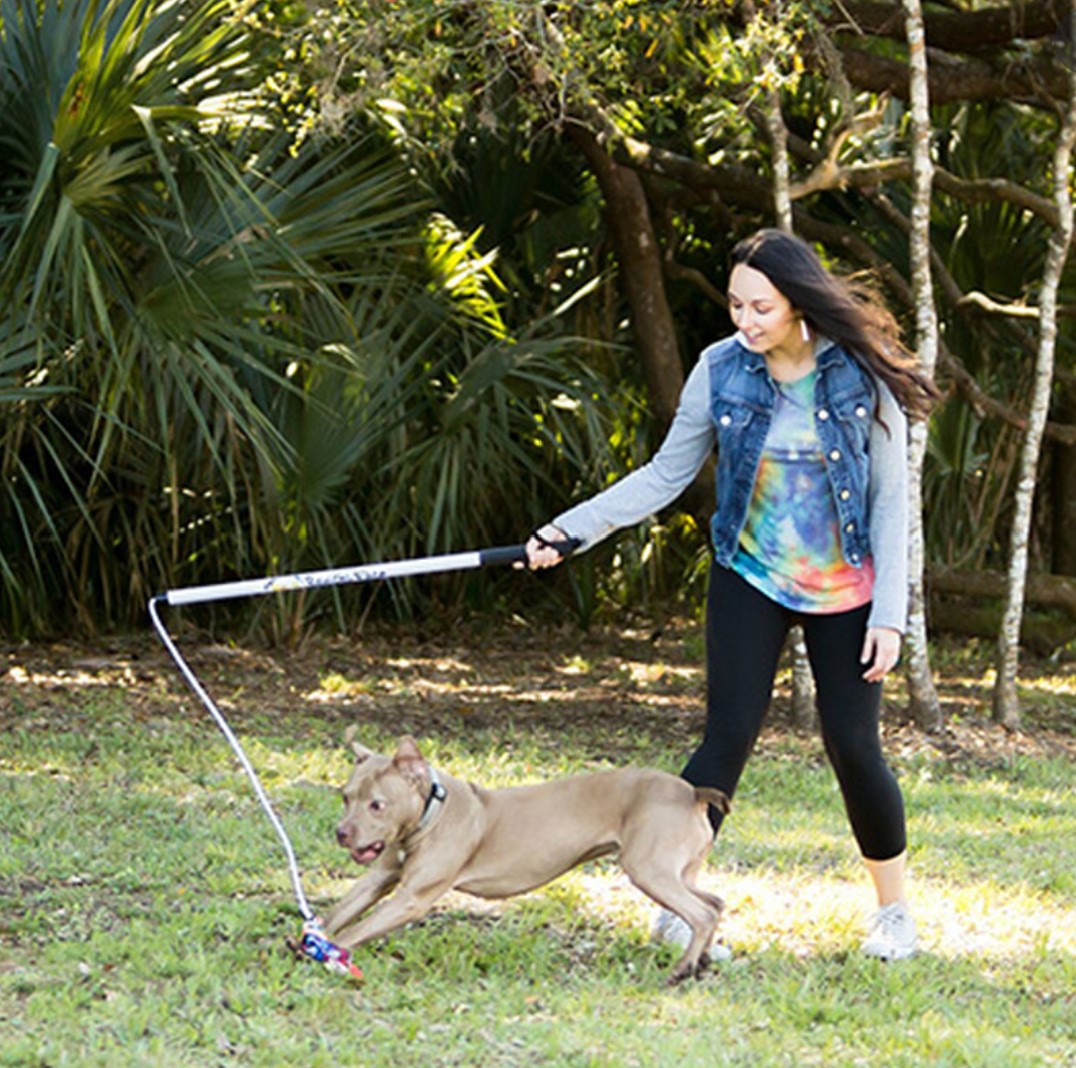


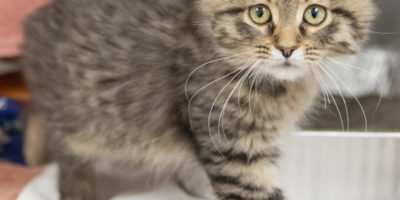
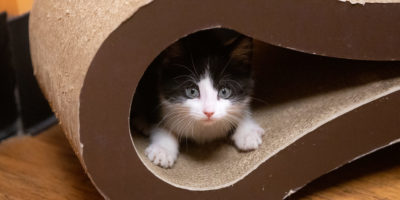
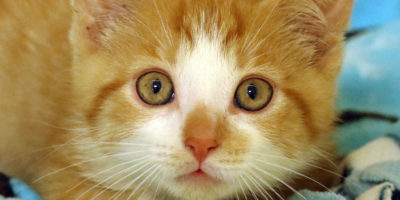



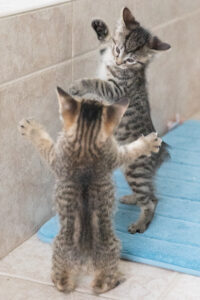
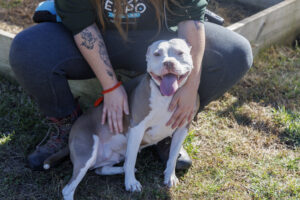
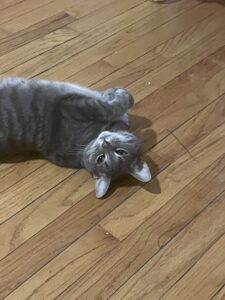
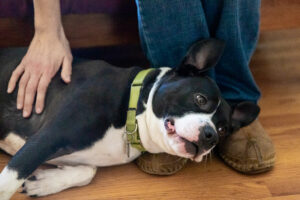
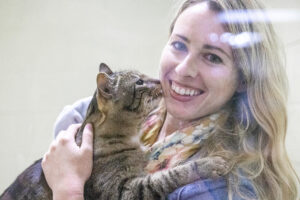
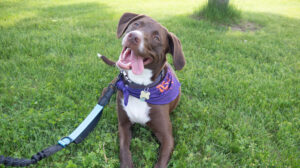
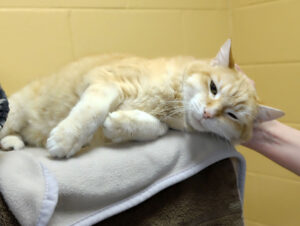
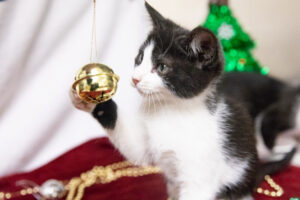

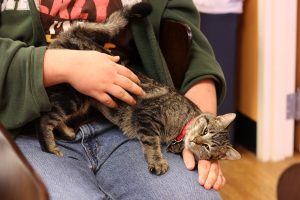
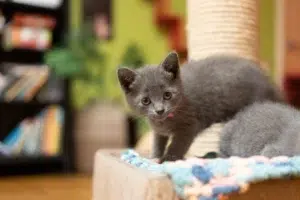
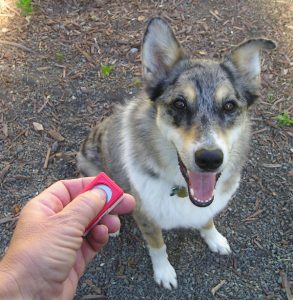
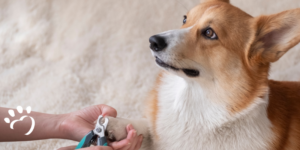
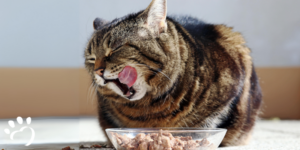
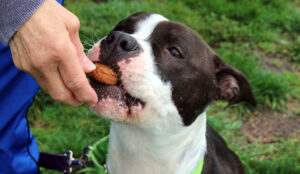
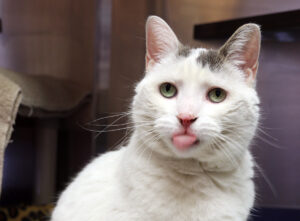

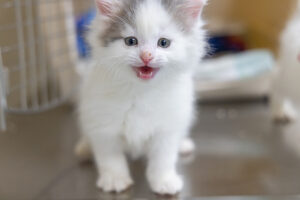
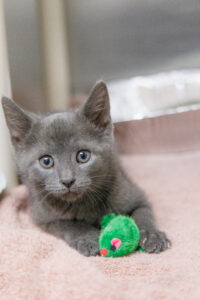

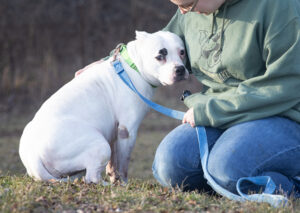

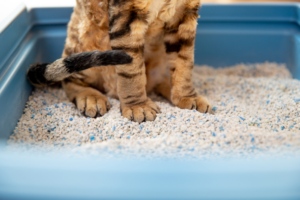
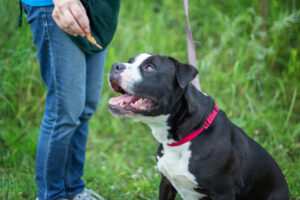
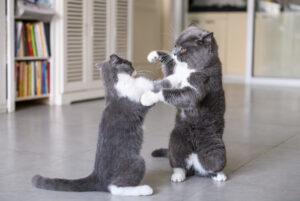


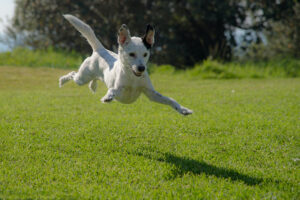

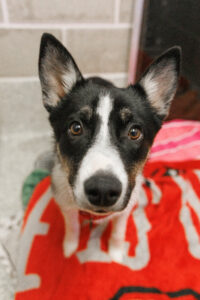
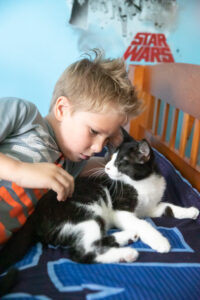
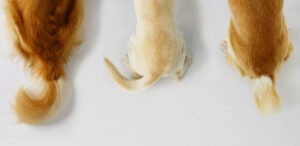

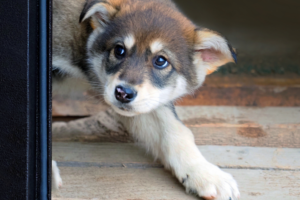
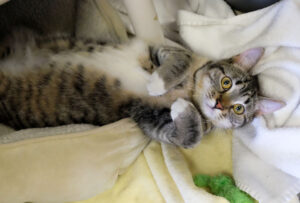

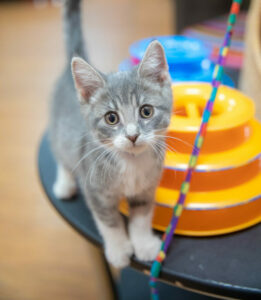
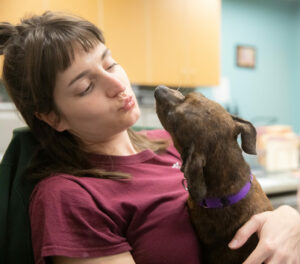
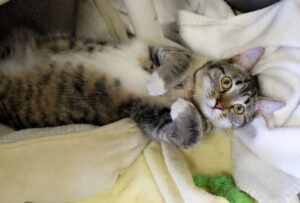
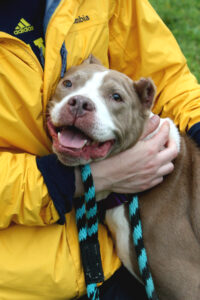
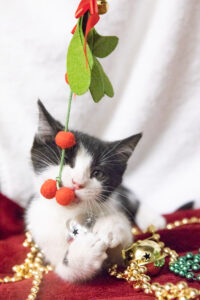





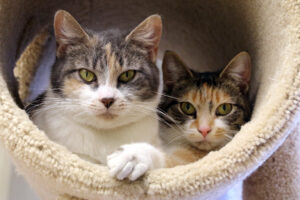
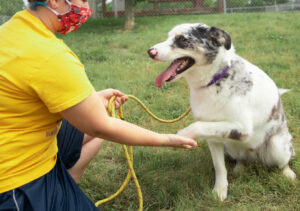
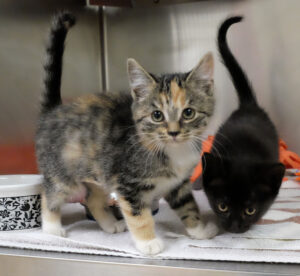

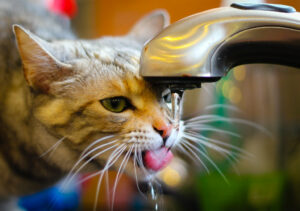

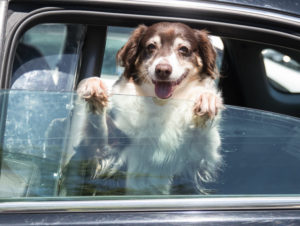
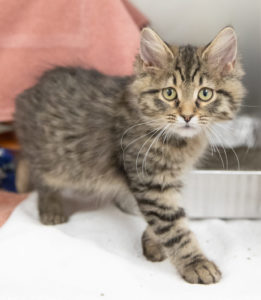
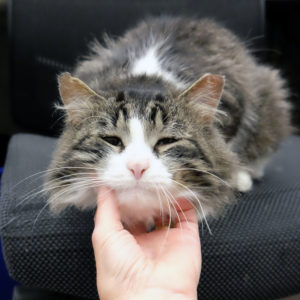

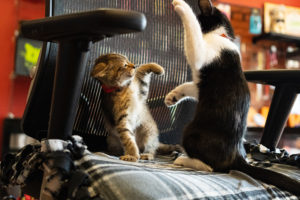




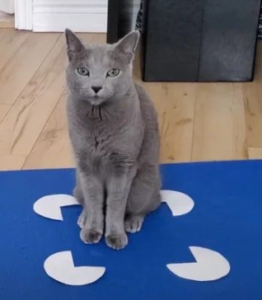

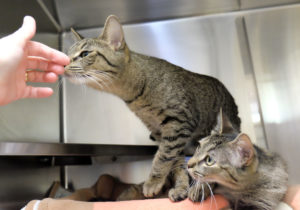
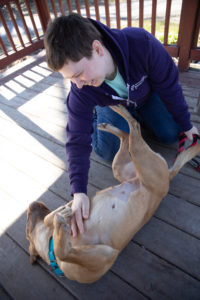
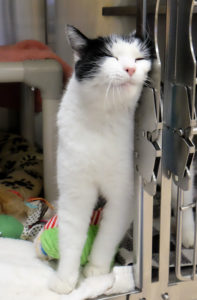
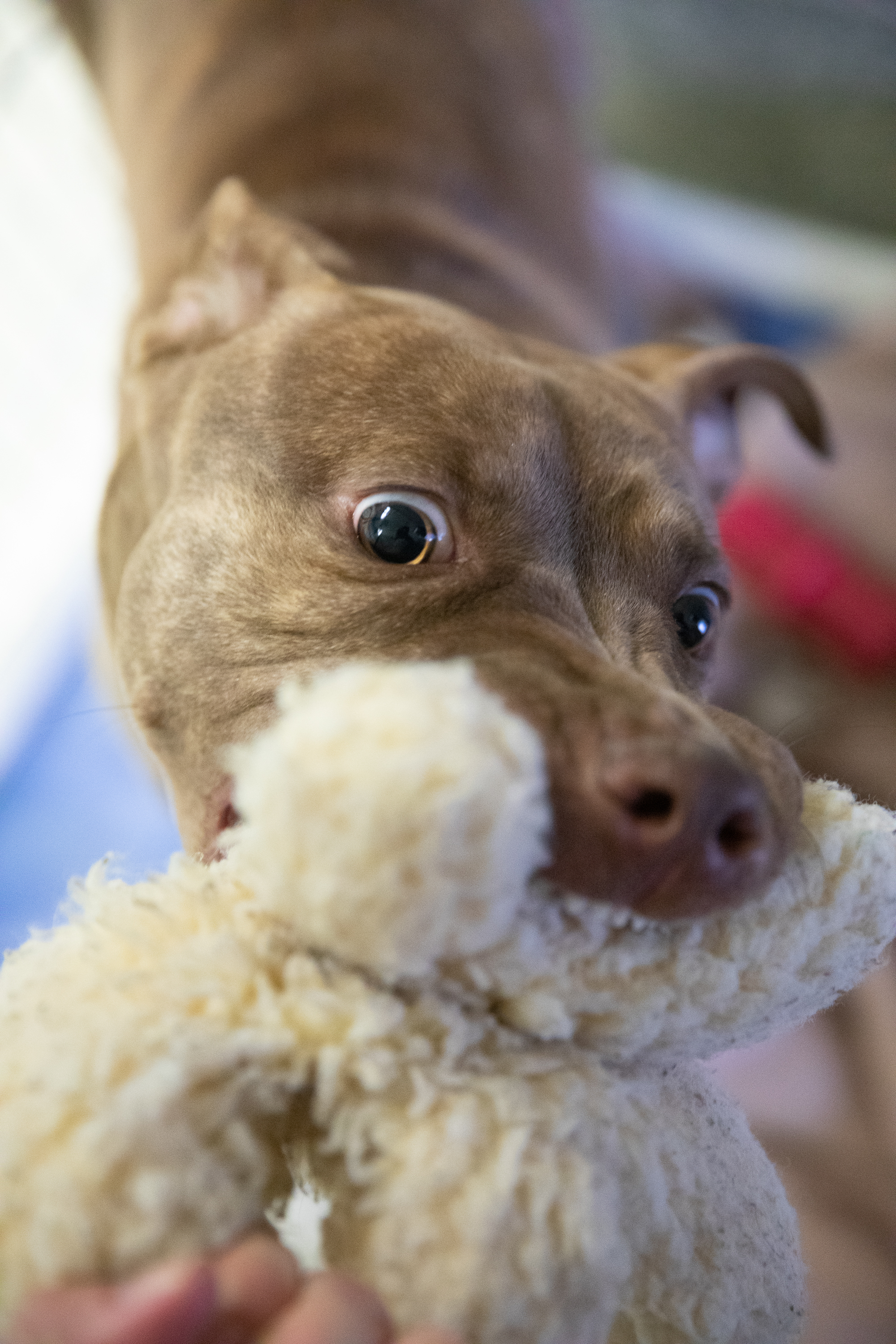
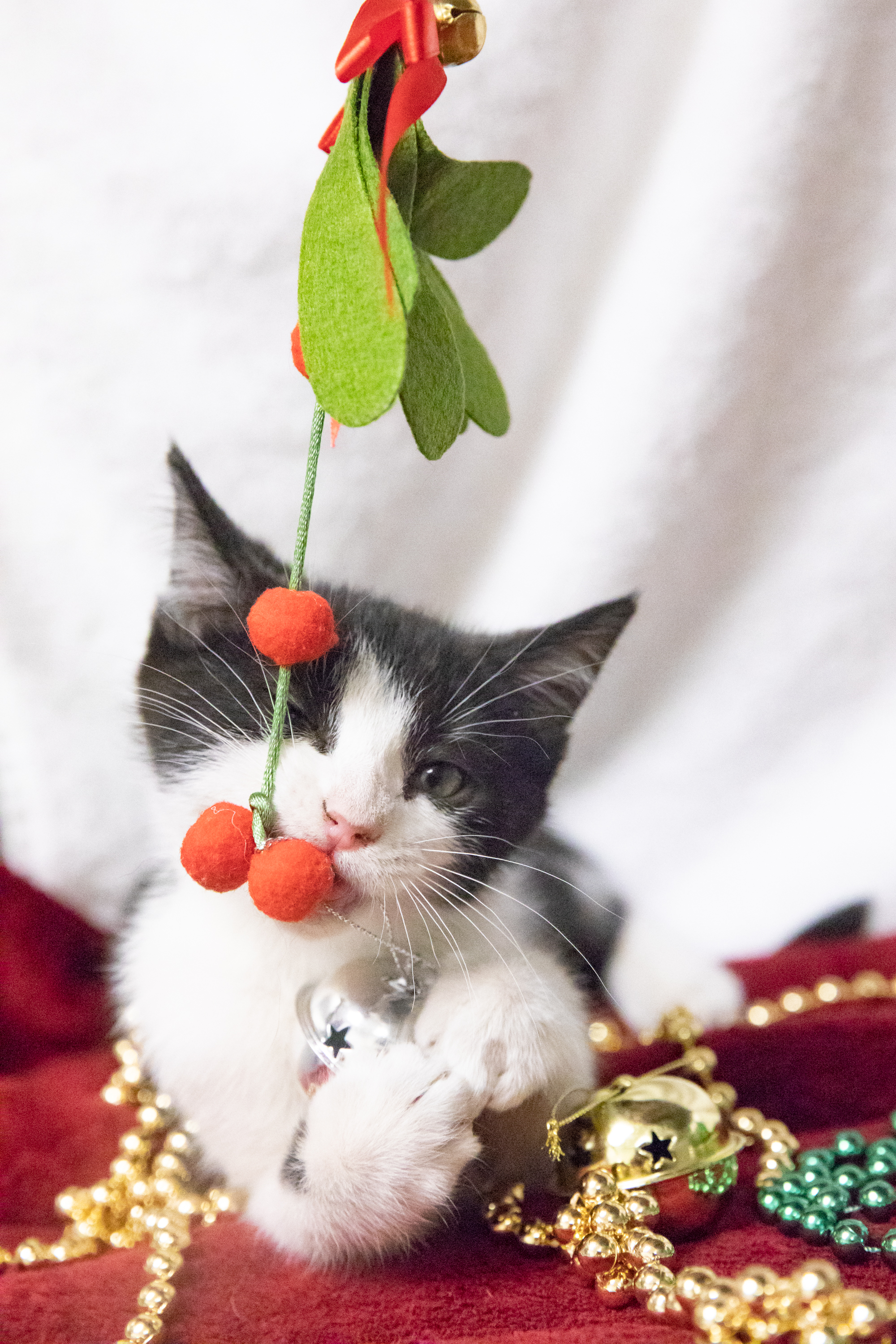
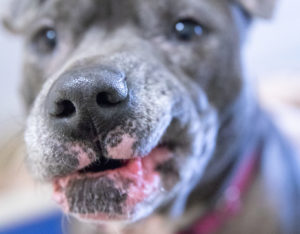
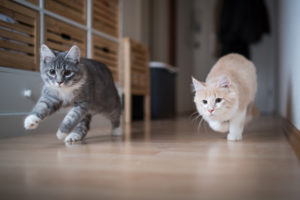
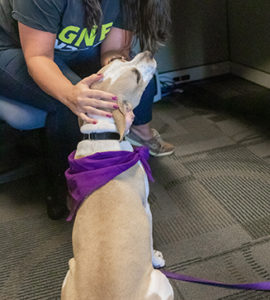

![[Photo by Erda Estremera on Unsplash]](https://www.hshv.org/wp-content/uploads/2020/08/erda-estremera-qg8hILdyl2w-unsplash-300x199.jpg)
